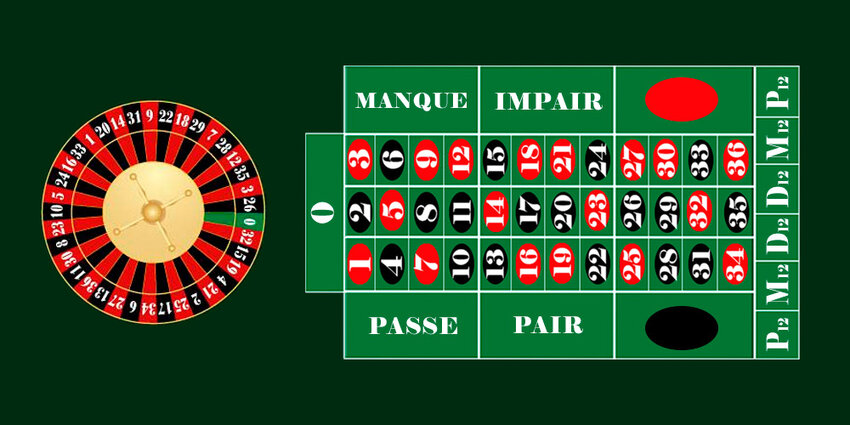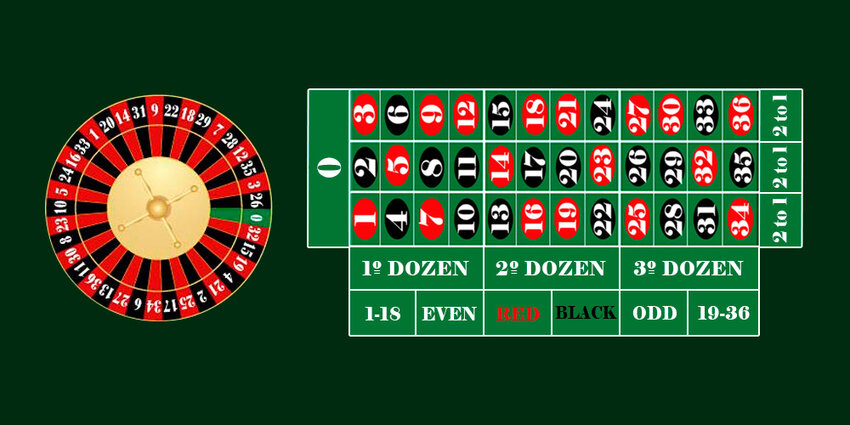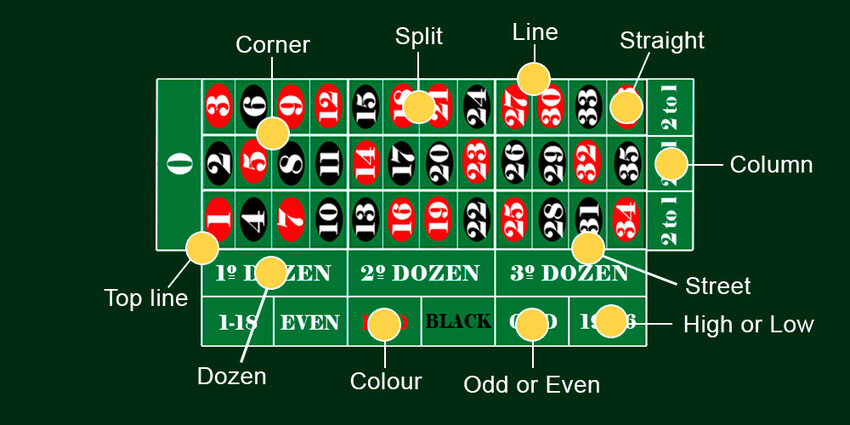The ultimate guide for the roulette: learn how to play like a pro
Want to become a roulette master? In this guide we tell you everything you need to know: types of roulette, betting types, rules of the game and other tips.
The roulette is one of the games that attracts the most attention in any casino, and where the most curious people tend to congregate to watch the players place their bets. Without a doubt, the adrenaline rush of watching the ball spin, while holding your breath for it to stop in the betting cell, makes roulette one of the most exciting games to play.
Technically, it is a very simple game: it consists of a wheel with a total of 37 numbers (or 38 in the case of American roulette), each of which is marked in a cell, and where a ball is thrown and spins until it lands in one of them. If the ball lands in the cel of your bet, you win. But really, the complexity of roulette lies in the number of bets that are spread out across the vast gaming table, and in knowing how to bet strategically to increase your chances of winning without exposing yourself to high risk.
In this complete guide, you'll learn everything you need to know to master roulette: what types of roulette wheels exist, the types of bets you can make, the rules of the game, and some tips on how to get the most out of your bets. Let's go!
Rules of Roulette
As explained above, playing roulette consists of predicting which cell the ball will land in on the game wheel. This wheel is divided into 37 or 38 squares with the numbers arranged in a special pattern to guarantee the arbitrariness of the game.
On the game board or table (whichever you prefer to call it), all the types of bets that can be placed are available. These are divided into two categories: inside bets (where you bet on the number where the ball will land) or outside bets (where you are allowed to bet on certain characteristics of the cell where the ball will land, e.g. whether it will be odd or even, red or black, etc.).
At the start of the game, players will have some time to place their chips on the different sections of the board where they want to place their bets. Players can place as many bets as they wish. Once this time is up, the croupier will throw the ball and it will start to spin until it stops in a square: if we are right in our bet, we will be paid according to the corresponding payout or multiplier. If we don't, the house will keep the bets we don't hit.
But what happens if the ball lands in the 0 cell? The particularity of the number zero is that it is a neutral number without the characteristics of the outside bets: it is neither odd nor even, it is neither red nor black, etc. This means that it is only valid for inside bets. If the ball lands on zero, all players will automatically lose their outside bets, which is why it is considered to be the number that gives the house the most advantage.
Types of Roulettes
Although there is evidence that roulette was already being played in Greco-Roman times, the real roulette as we know it today was designed in France in the 17th century by the mathematician Blaise Pascal. This is why the so-called French roulette is the most classic type of roulette you can find. However, there are nowadays two other types of roulette that have derived from this first one: European roulette and American roulette.
French Roulette:
This is the most classic type of roulette: it consists of a total of 37 numbers (from 0 to 36) and a table or board where the inside bets are concentrated in the centre, and the rest of the outside bets around.
This type of roulette is characterised by two special bets: "la partage" and "in prison", which are used in the event that the ball lands on the number 0. In these cases, the player who has placed outside bets can choose between these two options: if he chooses "la partage" the house gives him 50% of his bet back, but if he chooses " in prison" he can keep his bet until the next round, to have a new chance to hit.

American Roulette:
Unlike French roulette, American roulette consists of a total of 38 numbers, from 0 to 36 but adding an extra double zero (00) to the game. The existence of a double zero increases the house edge, as there is a greater chance that the ball will land in a cell where outside bets are not valid.
Also, the game board differs from that of French roulette, as all outside bets are placed on the same side as the inside bets.

European Roulette:
Arguably, European roulette is the most widespread version today, as it combines the characteristics of French and American roulette: on the one hand, it takes from French roulette the amount of numbers, as it is played with 37 numbers from 0 to 36, and on the other hand, it takes from American roulette the structure of the game board.
In addition, another peculiarity of this type of roulette is the existence of a "race track", which is an area outside the table that recreates the real order of the numbers in roulette, which makes it easier to place bets.

Types of Roulette Bets:
As mentioned above, there are two general types of bets in roulette: inside bets and outside bets. Inside bets allow you to bet on the exact numbers. External bets, allow you to bet on the general characteristics of the number. Let's take a closer look at them:

Internal bets:
- Straight: This consists of betting individually on each number. As the odds of hitting one number out of 36 are the lowest in the game, it is the type of bet that pays the highest reward: it pays 35 to 1.
- Split: Allows you to bet on two adjacent numbers by placing your chip where they intersect on the table. Pays 17 to 1.
- Street: Allows you to bet on 3 adjacent numbers by placing the chip at the end of a row on the table. Pays 11 to 1.
- Corner: Allows you to bet on 4 adjacent numbers by placing the chip at the intersection of their 4 corners. Pays 8 to 1.
- Top line: Only available in European and French roulette. Allows you to bet on the first 3 numbers of the first row plus the number 0. Pays 8 to 1.
- Five: Only available in American roulette. Allows you to bet on the 5 numbers left together between 0, 00, 1, 2 and 3. Pays 6 to 1.
- Line: Allows you to bet on two adjacent rows, i.e. 6 numbers at a time, by placing the chip on the intersection of the two rows at the end of the board. It pays 5 to 1.
Outside Bets:
- Red or Black: Allows you to bet on whether the winning number will be red or black. As there is a 50% chance of winning, the payout is lower: it pays 1 to 1.
- Odd or Even: Allows you to bet on whether the winning number will be odd or even. The payout is 1 to 1.
- High or Low number: In this bet the numbers are divided into two blocks: low (up to 18) and high (from 19 to 36). The payout is 1 to 1.
- Dozen: By dividing the 36 numbers into 3 dozens, you can bet on one of them. It pays 2 to 1.
- Column: As the table or board is divided into 3 columns, this type of bet allows you to bet on one of them. It pays 2 to 1.
Tips for playing roulette
Now that you know how it works, we'll give you some tips to help you play the roulette and make the most of your first bets, and learn to play like a pro little by little:
- Start by playing European roulette or French roulette. American roulette is the most difficult, as it includes a double chance of the ball landing on the number 0, which increases the house edge.
- Start by placing outside bets, but don't just stick to them. Outside bets are the most likely to be successful, as they generally carry a 50% or 33% chance. However, this is also why they have the lowest returns. While it is advisable to start with more outside bets than inside bets when you are starting out, also take the opportunity to include inside bets such as the line or corner, which allow you to bet on several numbers at once.
- Avoid covering the table. You may have read that the technique of "covering the table", which involves placing as many bets as possible to increase the odds of hitting one, is a technique used by more experienced players. However, it can be a double-edged sword, as it requires you to bet a lot more and, in case you don't win or only hit low bets, it is also possible to lose a lot in one play. So it is best avoided if you are just starting to learn.
- Have patience and a realistic budget. Mastering roulette takes time to gain experience. It is best to aim to start with a realistic and moderate budget so as not to spoil the fun. Remember, it's all about having fun first.
Best of luck with your next bet!





